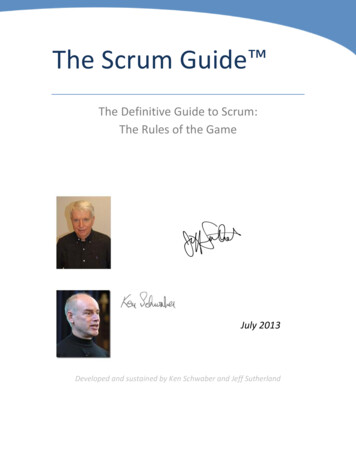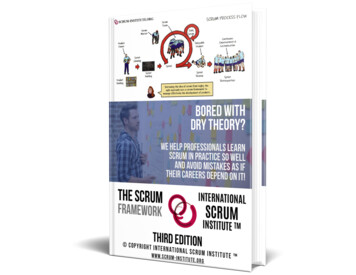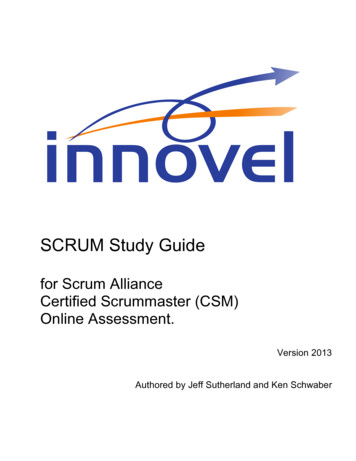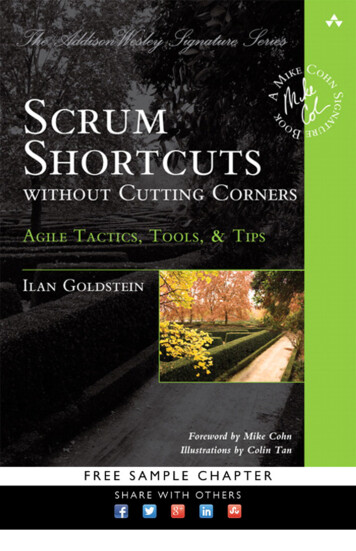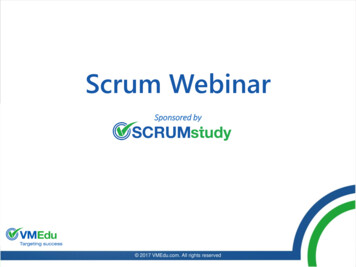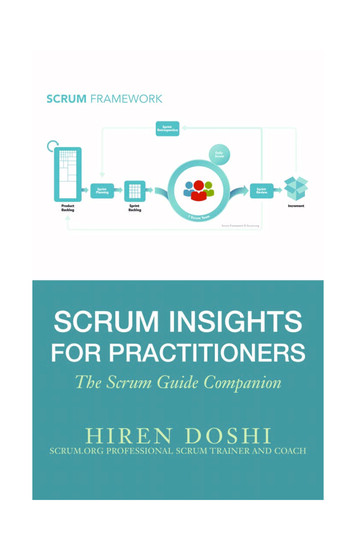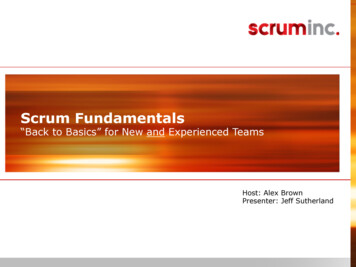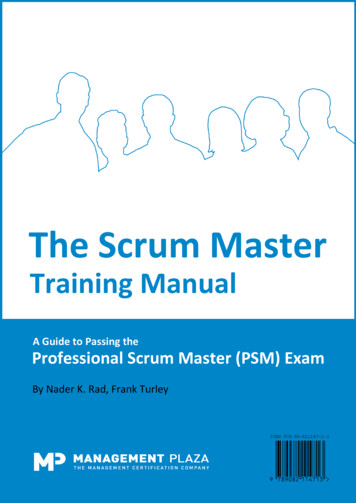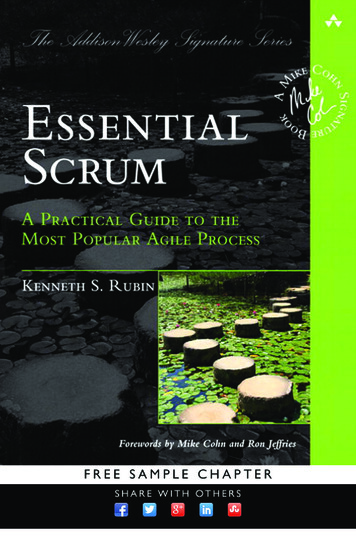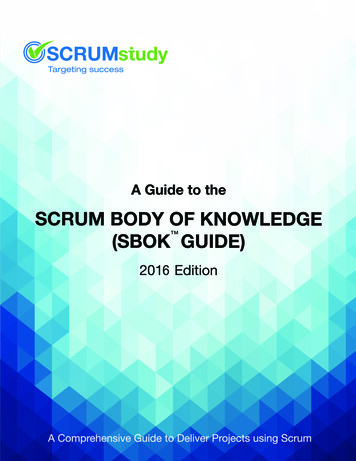
Transcription
6
A Guide to theSCRUM BODY OF KNOWLEDGE(SBOK Guide)2016 EditionA Comprehensive Guide to Deliver Projects using Scrum
2016 SCRUMstudy , a brand of VMEdu, Inc. All rights reserved.Library of Congress Cataloging-in-Publication DataA Guide to the Scrum Body of Knowledge (SBOK Guide) – 2016 editionIncludes bibliographical references and index.ISBN: 978-0-9899252-0-41. Scrum Framework. I. SCRUMstudy . II. SBOK Guide2013950625ISBN: 978-0-9899252-0-4Published by:SCRUMstudy , a brand of VMEdu, Inc.410 N 44th Street, Suite 240Phoenix, Arizona 85008 USAPhone: 1-480-882-0706Fax: 1-240-238-2987Email: sbok@scrumstudy.comWebsite: www.scrumstudy.com“SBOK”, the SCRUMstudy logo, “SDC”, “SMC”, “AEC”, “SPOC”, and “ESM” are trademarks of SCRUMstudy (a brand ofVMEdu, Inc.) For a comprehensive list of SCRUMstudy marks, contact the SCRUMstudy Legal Department.A Guide to the Scrum Body of Knowledge (SBOK Guide) is provided for educational purposes. SCRUMstudy or VMEdu,Inc. does not warrant that it is suitable for any other purpose and makes no expressed or implied warranty of any kind andassumes no responsibility for errors and omissions. No liability is assumed for incidental or consequential damages inconnection with or arising out of the use of the information contained herein.SCRUMstudy welcomes corrections and comments on its books. Please feel free to send comments on typographical,formatting, or other errors. You can make a copy of the relevant page of the book, mark the error, and send it to the aboveaddress or send an email to sbok@scrumstudy.com.No part of this work may be reproduced or transmitted in any form or by any means, electronic, manual, photocopying,recording, or by any information storage and retrieval system, without prior written permission of the publisher.10 9 8 7 6 5 4 3 2
PREFACEA Guide to the Scrum Body of Knowledge (SBOK Guide) provides guidelines for the successfulimplementation of Scrum—the most popular Agile product development and project delivery methodology.Scrum, as defined in the SBOK Guide, is a framework which is applicable to portfolios, programs, orprojects of any size or complexity; and may be applied effectively in any industry to create a product,service, or other result.The SBOK Guide was developed as a standard guide for organizations and professionals who want toimplement Scrum, as well as those already doing so who want to make needed improvements to theirprocesses. It is intended for use as a reference and knowledge guide by both experienced Scrum and otherproduct or service development practitioners, as well as by persons with no prior experience or knowledge ofScrum or any other project delivery methodology.The SBOK Guide draws from the combined knowledge and insight gained from thousands of projectsacross a variety of organizations and industries. In addition, contributions have been made by experts whohave taught Scrum and project delivery courses to more than 400,000 professionals in 150 countries. Itsdevelopment has truly been a collaborative effort from a large number of experts in a variety of disciplines. Inparticular, I would like to thank the seventeen co-authors and subject matter experts and the twenty-eightreviewers who greatly contributed to the creation of the SBOK Guide.Wide adoption of the SBOK Guide framework should help standardize how Scrum is applied to projectsacross organizations globally, as well as significantly help to improve their Return on Investment.Additionally, it should promote greater thought and deliberation regarding the application of Scrum to manytypes of projects, which will in turn contribute towards expanding and enriching the body of knowledge andconsequently future updates to this guide.Although the SBOK Guide is a comprehensive guide and framework for delivering projects using Scrum,its contents are organized for easy reference, regardless of the reader’s prior knowledge on the subject. Ihope each reader will learn from and enjoy it as much as the many authors and reviewers learned from andenjoyed the process of collating the collective knowledge and wisdom contained within it.Tridibesh Satpathy,Lead Author, SBOK Guide
TABLE OF CONTENTSTABLE OF CONTENTS1.INTRODUCTION . 11.11.1.11.21.2.1Brief History of Scrum . 3Why Use Scrum? . 4Scalability of Scrum . 51.3Purpose of the SBOK Guide. 61.4Framework of the SBOK Guide . 71.4.1How to Use the SBOK Guide? . 81.4.2Scrum Principles. 91.4.3Scrum Aspects . 111.4.4Scrum Processes . 161.52.Overview of Scrum. 2Scrum vs. Traditional Project Management . 20PRINCIPLES . 212.1Introduction . 212.2Roles Guide . 222.3Empirical Process Control . 222.3.1Transparency. 222.3.2Inspection . 242.3.3Adaptation . 242.42.4.12.5Self-organization . 27Benefits of Self-organization . 27Collaboration . 292.5.1Benefits of Collaboration in Scrum Projects. 292.5.2Importance of Colocation in Collaboration . 312.6Value-based Prioritization . 312.7Time-boxing . 332.7.12.8Scrum Time-boxes . 33Iterative Development . 36 2016 SCRUMstudy . A Guide to the Scrum Body of Knowledge (SBOK Guide)I
TABLE OF CONTENTS2.93.Scrum vs. Traditional Project Management . 38ORGANIZATION . 393.1Introduction . 393.2Roles Guide . 403.3Scrum Project Roles . 403.3.1Core Roles. 413.3.2Non-core Roles. 423.4Product Owner . 433.4.1Voice of the Customer (VOC) . 453.4.2Chief Product Owner . 453.5Scrum Master. 453.5.13.6IIScrum Team . 473.6.1Personnel Selection . 493.6.2Scrum Team Size . 493.74.Chief Scrum Master . 47Scrum in Projects, Programs, and Portfolios. 503.7.1Definition of Project, Program, and Portfolio . 503.7.2Scrum in Projects . 513.7.3Scrum in Portfolios and Programs . 533.7.4Maintaining Stakeholder Involvement . 553.8Summary of Responsibilities . 563.9Scrum vs. Traditional Project Management . 573.10Popular HR Theories and their Relevance to Scrum . 583.10.1Tuckman’s Model of Group Dynamics . 583.10.2Conflict Management . 593.10.3Conflict Management Techniques . 593.10.4Leadership Styles . 613.10.5Maslow’s Hierarchy of Needs Theory . 633.10.6Theory X and Theory Y. 64BUSINESS JUSTIFICATION . 654.1Introduction . 654.2Roles Guide . 66 2016 SCRUMstudy . A Guide to the Scrum Body of Knowledge (SBOK Guide)
TABLE OF CONTENTS4.34.3.1Responsibilities of the Product Owner in Business Justification . 684.3.2Responsibilities of Other Scrum Roles in Business Justification . 684.4Importance of Business Justification . 694.4.1Factors Used to Determine Business Justification. 694.4.2Business Justification and the Project Lifecycle . 704.5Business Justification Techniques . 724.5.1Estimation of Project Value. 724.5.2Planning for Value . 744.5.3Relative Prioritization Ranking . 764.5.4Story Mapping . 764.6Continuous Value Justification . 764.6.1Earned Value Analysis. 774.6.2Cumulative Flow Diagram (CFD) . 794.74.7.15.Value-driven Delivery . 66Confirm Benefits Realization . 80Prototypes, Simulations, and Demonstrations . 804.8Summary of Responsibilities . 814.9Scrum vs. Traditional Project Management . 82QUALITY . 835.1Introduction . 835.2Roles Guide . 845.3Quality Defined . 845.3.1Quality and Scope . 855.3.2Quality and Business Value . 855.4Acceptance Criteria and the Prioritized Product Backlog . 865.4.1Writing Acceptance Criteria . 885.4.2Minimum Acceptance Criteria . 885.4.3Definition of Done . 895.4.4Acceptance or Rejection of Prioritized Product Backlog Items . 905.5Quality Management in Scrum . 905.5.1Quality Planning . 915.5.2Quality Control and Quality Assurance . 92 2016 SCRUMstudy . A Guide to the Scrum Body of Knowledge (SBOK Guide)III
TABLE OF CONTENTS5.5.36.5.6Summary of Responsibilities . 945.7Scrum vs. Traditional Project Management . 95CHANGE . 976.1Introduction . 976.2Roles Guide . 986.3Overview . 986.3.16.4Change in Scrum . 100Balancing Flexibility and Stability. 1006.4.2Achieving Flexibility . 1016.5.16.6Integrating Change . 106Changes to a Sprint . 106Change in Portfolios and Programs . 1116.6.1In Portfolio . 1116.6.2In Program . 1126.7Summary of Responsibilities . 1146.8Scrum vs. Traditional Project Management . 115RISK . 1177.1Introduction . 1177.2Roles Guide . 1187.3What is Risk? . 1187.3.1Difference between Risks and Issues . 1187.3.2Risk Attitude . 1197.4IVUnapproved and Approved Change Requests . 996.4.16.57.Plan-Do-Check-Act (PDCA) Cycle. 93Risk Management Procedure. 1207.4.1Risk Identification . 1207.4.2Risk Assessment . 1217.4.3Risk Prioritization . 1247.4.4Risk Mitigation . 1267.4.5Risk Communication . 1267.5Minimizing Risks through Scrum . 1287.6Risks in Portfolios and Programs . 129 2016 SCRUMstudy . A Guide to the Scrum Body of Knowledge (SBOK Guide)
TABLE OF CONTENTS8.7.6.1In Portfolio . 1297.6.2In Program . 1297.7Summary of Responsibilities . 1317.8Scrum vs. Traditional Project Management . 132INITIATE . 1338.18.1.1Inputs . 1398.1.2Tools. 1428.1.3Outputs . 1438.2Identify Scrum Master and Stakeholder(s) . 1458.2.1Inputs . 1478.2.2Tools. 1498.2.3Outputs . 1518.3Form Scrum Team . 1528.3.1Inputs . 1548.3.2Tools. 1558.3.3Outputs . 1568.4Develop Epic(s). 1588.4.1Inputs . 1608.4.2Tools. 1638.4.3Outputs . 1658.5Create Prioritized Product Backlog . 1678.5.1Inputs . 1698.5.2Tools. 1708.5.3Outputs . 1728.6Conduct Release Planning. 1748.6.1Inputs . 1768.6.2Tools. 1778.6.3Outputs . 1788.79.Create Project Vision . 137Phase Data Flow Diagram . 180PLAN AND ESTIMATE . 1819.1Create User Stories . 185 2016 SCRUMstudy . A Guide to the Scrum Body of Knowledge (SBOK Guide)V
TABLE OF CONTENTS9.1.1Inputs . 1879.1.2Tools. 1889.1.3Outputs . 1909.2Approve, Estimate, and Commit User Stories . 1929.2.1Inputs . 1939.2.2Tools. 1939.2.3Outputs . 1969.3Create Tasks. 1979.3.1Inputs . 1989.3.2Tools. 1989.3.3Outputs . 2009.4Estimate Tasks . 2019.4.1Inputs . 2029.4.2Tools. 2039.4.3Outputs . 2049.59.5.1Inputs . 2079.5.2Tools. 2089.5.3Outputs . 2099.610.Phase Data Flow Diagram . 210IMPLEMENT . 21110.1Create Deliverables . 21510.1.1Inputs . 21710.1.2Tools. 21910.1.3Outputs . 22010.2Conduct Daily Standup . 22210.2.1Inputs .
A Guide to the Scrum Body of Knowledge (SBOK Guide) provides guidelines for the successful implementation of Scrum—the most popular Agile product development and project delivery methodology. Scrum, as defined in the SBOK Guide, is a
